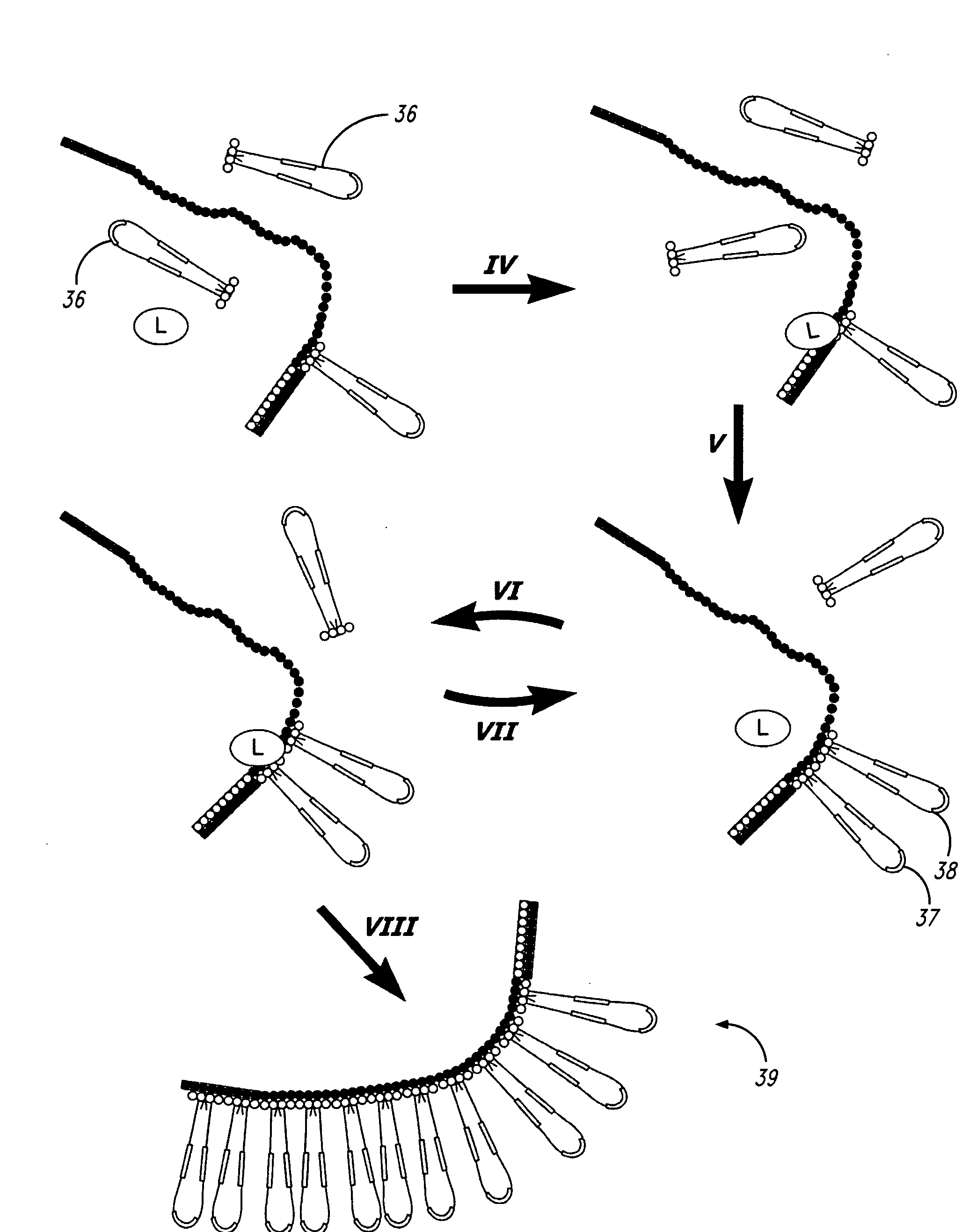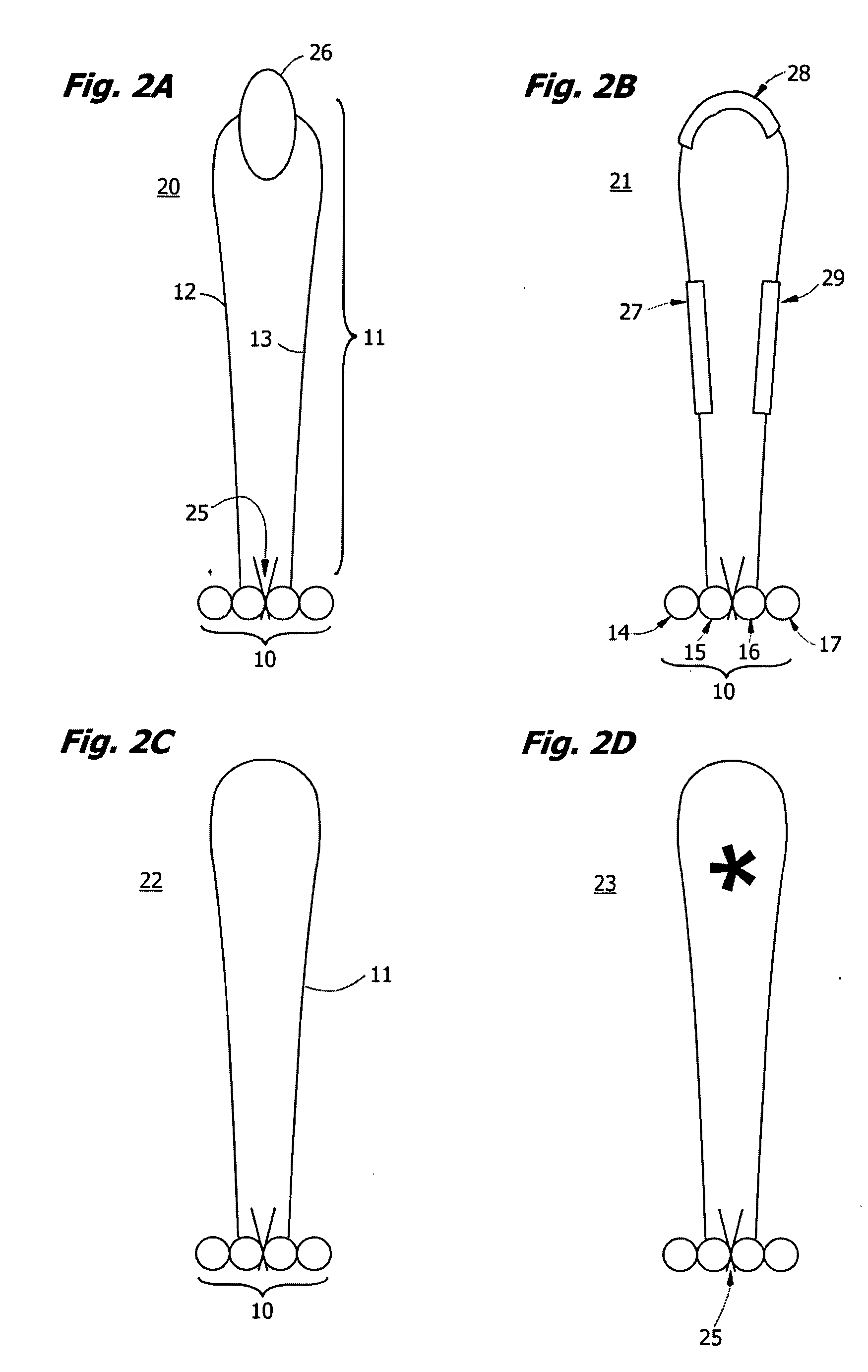High throughput nucleic acid sequencing by expansion
a nucleic acid and expansion technology, applied in the field of nucleic acid sequencing, can solve the problems of limited read length, low throughput, and high cost of “sequencing by synthesis” methods, and achieve the throughput, cost and quality targets required by market-leading whole genome sequencing for personalized medicine, and achieve the effect of increasing the linear separation of individual elements and being easy to d
- Summary
- Abstract
- Description
- Claims
- Application Information
AI Technical Summary
Benefits of technology
Problems solved by technology
Method used
Image
Examples
example 1
Synthesis of a Chimeric 2mer Xprobe “CA” with Selectively Cleavable Ribosyl-5′-3′ Internucleotide Bond
[0580]Oligomeric Substrate constructs are composed of probe members and tether members and have a general “probe-loop” construction. Probe member synthesis is accomplished using well established methods of solid phase oligomer synthesis. In these methods, addition of nucleobases to a nascent probe chain on a resin is accomplished with phosphoramidite chemistry (U.S. Pat. Nos. 4,415,732 and 4,458,066) for example, and milligrams or grams of synthetic oligomer can be economically synthesized using readily available automated synthesizers. Typical solid-phase oligonucleotide synthesis involves reiteratively performing four steps: deprotection, coupling, capping, and oxidation. However, at least one bond in the probe of a class I Xprobe substrate construct is a selectively cleavable bond, and at least two probe moieties are modified for acceptance of a tether member. The selectively cle...
example 2
Synthesis of a 4mer Xprobe “TATA” with Selectively Cleavable Phosphorothiolate Bond
[0583]Xprobe 4mers can be synthesized with a phosphorothiolate linkage as the selectively cleavable bond. For the following example, synthesis of a 5′ phosphate (dT) (aminoC6-dA) (dT) (aminoC6-dA) 3′ tetranucleotide is described.
[0584]A 5′ mercapto-deoxyThymidine is first prepared as described by Mag et al. (“Synthesis and selective cleavage of an oligodeoxynucleotide containing a bridged internucleotide 5′-phosphorothioate linkage”, Nucl Acids Res 19:1437-41, 1991). Thymidine is reacted with two equivalents of p-toluenesulfonyl chloride in pyridine at room temperature, and the resulting 5′-tosylate is isolated by crystallization from ethanol. The tosylate is converted to a 5′-(S-trityl)-mercapto-5′-deoxy-thymidine with five equivalents of sodium tritylthiolate (prepared in situ). The 5′-(S-trityl)-mercapto-thymidine nucleotide is purified and reacted with 2-cyanoethoxy-bis-(N,N-diisopropylamino-phosp...
example 3
Synthesis of a 3mer Xprobe “CTA” with Selectively Cleavable 5′-3′ Phosphodiester Bond
[0588]Xprobes can also be synthesized with a phosphodiester linkage as the selectively cleavable bond. For the following example, synthesis of a 5′ phosphate (aminoC6-dC) (aminoC6-dT) (dA) 3′ trinucleotide with a non-bridging phosphorothioate modification is described. Phosphodiester bonds are attacked by a variety of nucleases. A phosphorothioate bond, with non-bridging sulfur, is used as a nuclease-resistant bond in this example.
[0589]For automated synthesis in the 3′ to 5′ direction, a CPG immobilized deoxyAdenosine solid support is used (5′-Dimethoxytrityl-N-benzoyl-2′-deoxyAdenosine, 3′-succinoyl-long chain alkylamino-CPG 500). In the first cycle, amino modifier C6 deoxyThymidine phosphoramidite (5′-Dimethoxytrityl-5-[N-(trifluoroacetylaminohexyl)-3-acrylimido]-2′-deoxyUridine, 3′-[(2-cyanoethyl)-(N,N-diisopropyl)]-phosphoramidite) is coupled. Before capping, the immobilized dA is reacted with ...
PUM
 Login to View More
Login to View More Abstract
Description
Claims
Application Information
 Login to View More
Login to View More - R&D
- Intellectual Property
- Life Sciences
- Materials
- Tech Scout
- Unparalleled Data Quality
- Higher Quality Content
- 60% Fewer Hallucinations
Browse by: Latest US Patents, China's latest patents, Technical Efficacy Thesaurus, Application Domain, Technology Topic, Popular Technical Reports.
© 2025 PatSnap. All rights reserved.Legal|Privacy policy|Modern Slavery Act Transparency Statement|Sitemap|About US| Contact US: help@patsnap.com



